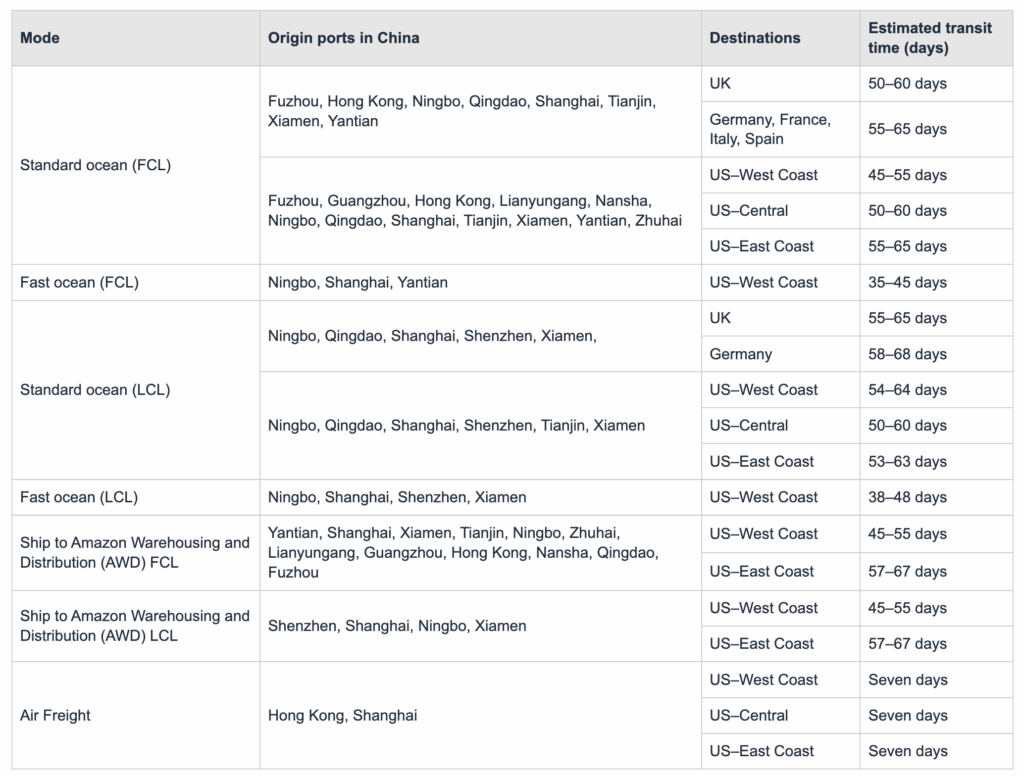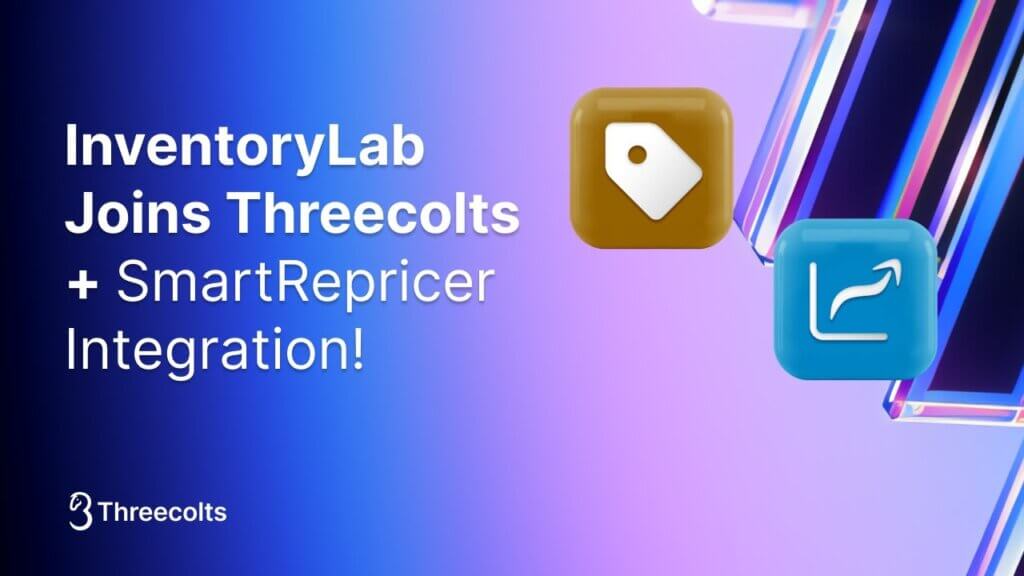- Blog
-
For Sellers
How Amazon Global Logistics simplifies international shipping
Amazon now books your freight from China to FBA, but you’ll still need to do some math.

Getting inventory from your supplier in China to Amazon fulfillment centers used to mean juggling freight forwarders, customs brokers, and endless paperwork. Amazon Global Logistics changed that game by creating an end-to-end shipping service that handles everything from pickup to delivery.
Think of it as Amazon’s answer to the headaches of international shipping. Instead of coordinating with multiple vendors, you book everything through Seller Central and let Amazon’s logistics network handle the rest.
What is Amazon Global Logistics?
Amazon Global Logistics (AGL) is Amazon’s integrated freight service that ships your FBA inventory from China and Vietnam directly to fulfillment centers across multiple countries. The service covers ocean freight (both full containers and shared space) plus air freight for faster delivery.
Available shipping routes include:
- China/Vietnam → United States
- China → United Kingdom
- China → European Union (Germany, France, Italy, Spain)
- China → Japan
The real advantage here is simplicity. AGL handles pickup from your supplier, ocean or air transportation, customs clearance, and final delivery to Amazon’s fulfillment centers. You get one point of contact instead of managing multiple service providers.
Air freight gets your inventory to the US in about seven days, while ocean shipping takes 35-68 days, depending on your route and service level. Ocean freight costs significantly less but requires more planning due to longer transit times.
How the placement system works
Amazon’s placement system determines where your inventory ends up once it reaches the destination country. Your choice here directly impacts both your shipping costs and how quickly your products become available for sale.
Amazon Managed Placement (AMP)
Amazon Managed Placement simplifies everything by letting Amazon decide where to distribute your inventory. You ship to one location, and Amazon splits your products across multiple fulfillment centers for optimal placement.
The major benefit is cost predictability. AMP includes all placement fees in one flat rate, so you avoid separate FBA inbound placement service fees. Your inventory also enters the fulfillment network faster since shipments go to facilities close to destination ports.
Requirements for AMP:
- Maximum 2,000 boxes per 40-foot container
- Maximum 1,000 boxes per 20-foot container
- Can’t mix different product size categories in the same container
AMP works best for high-density shipments where you’re packing lots of units into each container. The more units you can fit, the better your per-unit economics become.
Minimal shipment splits
This option sends your inventory to a single fulfillment center on either the East or West Coast. You’ll pay standard FBA inbound placement service fees, but you maintain more control over exactly where your products land.
Minimal shipment splits can be more cost-effective for low-density shipments where you have fewer units per container. The placement fees might be lower than AMP’s flat rate structure, depending on your specific situation.
The downside is that shipping to just one fulfillment center means longer delivery times for customers in distant regions. Your West Coast inventory won’t reach East Coast buyers as quickly.
Seller Managed Placement (SMP)
Starting July 2025, Seller Managed Placement gives you the most control over inventory distribution. You divide shipments across five US regions, sending products directly to regional cross-docks.
SMP benefits:
- Zero FBA inbound placement fees
- Faster delivery times due to regional distribution
- Ability to consolidate standard-size items by region
To qualify for SMP, you need at least five identical boxes per ASIN mix and must stick to standard-size (sortable) cargo. This option requires more logistics coordination but can deliver significant cost savings for larger sellers.
Ship to Amazon Warehousing and Distribution
AWD combines shipping with bulk storage, letting Amazon automatically replenish your FBA inventory as needed. Your products go to an AWD facility first, then get distributed to fulfillment centers when inventory runs low.
This option works well if you want to maintain higher inventory levels without paying FBA storage fees on everything upfront. AWD pricing covers placement services, so you avoid separate inbound fees.
Cost comparison examples
Let’s work through a realistic scenario: shipping 15,000 units of kitchen gadgets from Shanghai to the US in a 40-foot container. Here’s how the different placement options would impact your total costs:
Seller Managed Placement: $6,870 total cost
- $6,250 shipping (5 regional shipments averaging $1,250 each)
- $395 import clearance fees (5 shipments × $79 each)
- $225 additional handling for regional splits
- $0 placement fees
Amazon Managed Placement: $9,150 total cost
- $8,950 shipping (single consolidated rate with placement included)
- $125 import clearance for a single shipment
- $75 container handling fee
- $0 separate placement fees
Minimal Shipment Splits: $11,875 total cost
- $4,200 base shipping to the West Coast
- $125 import clearance
- $4,550 placement fees ($0.35 × 13,000 eligible units)
- $3,000 estimated additional fees for cross-country distribution
The math changes significantly for lower-density shipments. With just 6,000 units of bulky home decor items, minimal shipment splits drop to around $7,200 total cost, while AMP stays roughly the same at $9,100.
The step-by-step booking process
Getting started with AGL requires some upfront setup, but the process becomes straightforward once your profile is configured. You’ll need to establish payment methods and import compliance before booking your first shipment.
Profile setup requirements:
- Choose payment method (USD through Seller Central or CNY via wire transfer)
- Set up Importer of Record (IOR) information
- Provide company details and tax information
The booking process happens through Seller Central’s standard FBA workflow. Select “Yes, I want to ship freight with Amazon” when creating your shipment plan, then follow the guided steps.
Core booking information includes:
- Shipping mode (ocean FCL, LCL, or air freight)
- Origin location and pickup preferences
- Cargo ready date and shipment dimensions
- Product descriptions and compliance details
Amazon provides instant quotes based on current rates, though final costs depend on actual weight and volume measurements. The quote includes freight and customs clearance but excludes import duties, taxes, and FBA fees.
Product compliance documentation is crucial here. You’ll need detailed commodity descriptions, HTS codes, and manufacturer information. Vague descriptions like “electronics” can cause customs delays, while specific descriptions like “laptop computers” sail through clearance.
Transit times and capacity planning
Transit times vary significantly based on your chosen route and shipping method. Air freight delivers predictable seven-day service to all US destinations, while ocean options range from 35-68 days depending on ports and service levels.

Typical ocean transit times to the US:
- Fast ocean (FCL): 35-45 days to the West Coast
- Standard ocean (FCL): 45-55 days West Coast, 55-65 days East Coast
- Standard ocean (LCL): 54-64 days West Coast, 53-63 days East Coast
European routes take slightly longer, with UK destinations requiring 50-60 days and mainland Europe needing 55-68 days for standard ocean service.
Starting May 2025, AGL shipments only count toward your FBA capacity limits once vessels reach the destination port. This change gives you more flexibility to create purchase orders early without immediately hitting capacity restrictions.
The capacity improvement is significant for inventory planning. You can book shipments weeks in advance without worrying about artificial capacity constraints while your products are still crossing the ocean.
Costs and payment options
AGL rates vary by origin, destination, shipping mode, and placement option. The pricing structure includes base freight rates plus additional charges for placement, customs clearance, and any value-added services you select.
You can pay through two methods. USD payment via your Seller Central disbursement account charges your balance within 48 hours after delivery. CNY payment through wire transfer via Shipper Central gives you local currency options.
Hidden costs to watch for:
- Pickup fees (provided 48 hours after booking if Amazon handles pickup)
- Customs duties and taxes (excluded from base quotes)
- Amendment fees if you change bookings after submission
- Defect fees for shipping plan violations
The documentation makes clear that actual costs may differ from quotes if your estimated weights and volumes don’t match reality. Building some buffer into your estimates helps avoid surprise charges.
Restrictions and compliance requirements
AGL has strict limitations on what products you can ship. Most dangerous goods are prohibited, with limited exceptions for certain lithium battery configurations that meet specific packing requirements.
Prohibited items include:
- Standalone lithium batteries (UN3480, UN3090)
- Agricultural products requiring special permits
- Alcohol and vehicle tires (completely prohibited)
- Food, supplements, and medical devices without proper documentation
Should you use Amazon Global Logistics?
AGL makes the most sense for sellers who value simplicity over cost optimization. If you’re currently juggling multiple freight forwarders and customs brokers, the integrated approach can reduce headaches significantly.
AGL works best when you:
- Ship regular volumes from China/Vietnam to major markets
- Want predictable pricing without surprise fees
- Prefer managing everything through Seller Central
- Don’t have existing freight relationships you want to maintain
Consider alternatives if you:
- Need the absolute lowest shipping costs
- Ship irregular or small volumes
- Have complex products requiring specialized handling
- Already have efficient freight processes in place
The decision often comes down to your tolerance for complexity versus cost. Experienced sellers with established logistics networks might get better rates elsewhere, while newer sellers often find AGL’s simplicity worth the premium.
Volume sellers should pay special attention to the placement options. SMP can deliver significant savings for high-volume shippers, while smaller sellers might prefer AMP’s predictable pricing.
Getting started with Amazon Global Logistics
Setting up AGL starts with creating your profile through the Amazon Global Logistics portal. You’ll choose your destination market and provide the required business and tax information.
The initial setup includes downloading onboarding guides specific to your destination markets. Amazon provides separate guides for US destinations versus UK/EU routes, each covering the specific requirements for those regions.
Your first booking checklist:
- Complete AGL profile setup with payment method
- Gather supplier information and product documentation
- Prepare accurate commodity descriptions and HTS codes
- Choose placement option based on your volume and density
- Book within Seller Central using standard FBA workflow
While AGL handles the international shipping complexity, you’ll still need tools to manage your inventory once it reaches Amazon’s fulfillment centers. This is where complementary solutions become valuable.
Consider tools that help with FBA prep and shipment creation, inventory monitoring during long transit times, and profit tracking that accounts for international shipping costs. The 45-65 day transit times for ocean freight make inventory planning and business monitoring especially important.
Ready to streamline your international shipping while optimizing your entire selling workflow? Try Seller 365 free for up to 14 days and get the complete toolkit that works seamlessly with Amazon.






















